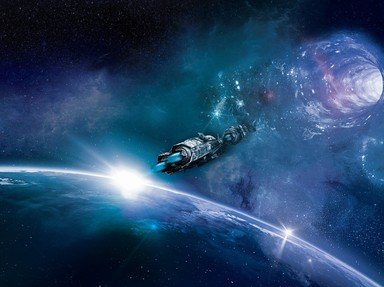Quiz Answer Key and Fun Facts
1. H.G. Wells, in "The War of the Worlds" (1898), described alien invaders who came from a place relatively close to home: Mars. They sought to exterminate humanity, and they knew no mercy: around the world, all hope seemed lost. But then help came, from an unexpected quarter. How were the Martians defeated?
2. Before the Space Age, history teachers talked about the Hundred Years' War, but for those who fought it "The Forever War" was far more disorienting. To battle the Taurans, we sent conscripts through collapsars to distant planets - but even the survivors could never truly go home again. Why not?
3. We never learned whether the slug-like things had intelligence of their own, but they nearly conquered us even so. They came from Pluto, touched down near Des Moines, and turned their human hosts into fifth columnists. Robert Heinlein recorded this story; who were our attackers?
4. They were machines created for war, implacable in their programmed goal: to destroy all life. At first, they were more successful than had ever been dreamed, wiping out the enemy root and branch. But no one had told them when to stop, and next they turned on their makers -- and then, the rest of the galaxy. Who were these beings of war, stars of a series by Fred Saberhagen?
5. The Star Kingdom of Manticore was a peaceful place, made wealthy through trade. So how did it end up embroiled in decades of interstellar war with several successive governments of the Republic of Haven? And how did it end up annexing so many systems that it had to change its name to the Star *Empire* of Manticore? The answers are perhaps best chronicled in the life of one of Manticore's greatest military heroes, a treecat-bonded woman who was somehow always in the thick of things. Name her.
6. With thousands of sentient peoples around the galaxy, all competing to settle roughly the same set of habitable worlds, there was bound to be conflict. So the Colonial Union, charged with shepherding humanity to the stars, assembled an army. In John Scalzi's "Old Man's War" (2005), how did they go about doing this?
7. As Larry Niven told it, humanity's introduction to Known Space was not a happy one. Pacifists by culture and conditioning, human spacefarers were attacked, setting off the first of the brutal Man-Kzin Wars. What Earth species did the vicious kzinti most resemble?
8. It may surprise you to know that our alien foes landed on Earth in 1942. Expecting from outdated satellite data to face no military technology more formidable than swords and shining armor, the Lizards were startled to find themselves fighting several industrialized powers in the midst of military and technological buildup. What star of alternate history chronicled the Lizards' confusion and the humans' revenge?
9. Within a multi-planet empire, there should be peace, but in this one, terrible wars between the noble houses were distressingly commonplace. Worlds did not often fight due to the high prices charged by the Guild for troop transport, but the Harkonnens paid a fortune to go after the Atreides family and their Fremen supporters on the planet of Arrakis. What book chronicled this epic struggle?
10. The invasions, from the destruction of our asteroid colonies to the Scourging of China, changed life on Earth. To begin, it was illegal to have a third child, except by special permit. We sent our best and brightest children to space to train as our admirals. And when Ender Wiggin finally ended that threat, our child tacticians nearly tore the world apart. What Earth animals most resemble the enemies we remade our world to fight?
Source: Author
CellarDoor
This quiz was reviewed by FunTrivia editor
agony before going online.
Any errors found in FunTrivia content are routinely corrected through our feedback system.

